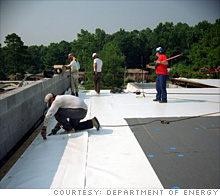White roofs to fight global warming
U.S. energy secretary Chu backs a novel idea: to whitewash roofs and highways. It could save lots of money and highlights an increasingly proactive agency.
 |
| Making a roof a cooler shade of white. |
NEW YORK (CNNMoney.com) -- America should attack global warming by ... painting rooftops and road surfaces white.
Seriously. No kidding.
Among those promoting the idea is Energy Secretary Steven Chu, a big-thinking physicist who has a bully pulpit and influence over billions in research and stimulus funds.
Chu spoke about the idea at a London conference last month while Congress was busy hashing out a complex, 1,400-page bill to cut greenhouse gases.
Whitening the world's roofs and roads would have the same effect on global warming as removing all the world's cars for 11 years, he said.
"So I'd like to appeal to all people -- we should convert to white limousines," he said.
Chu was joking about the limousines, of course. But his proposal for addressing climate change is genuine.
It sounds kooky, but environmentalists say the idea is legit.
They say recent research shows it's even more beneficial than previously thought. Moreover the Energy Department, flush with $38 billion in stimulus money, is in a position to make it happen.
Chu's comments were based on recent research from Arthur Rosenfeld, a former colleague of Chu's at the Energy Department's Lawrence Berkeley National Laboratory. Chu's all cars for 11 years number is meant to be illustrative -- no one really expects all roofs and all roads will be painted white.
But for new projects and some retrofits, it does make sense.
A white roof has three benefits:
- It keeps buildings cooler, reducing the amount of energy required for air conditioning.
- It reduces the so-call "heat island" effect, the heating up of entire urban areas which then causes other buildings in the vicinity to heat up, whether they are in direct contact with the sun or not.
- A white roof or road will actually reflect the sun's rays back into space, keeping the atmosphere cooler.
"This is a great idea," said Lane Burt, an energy policy analyst at the Natural Resources Defense Council. "We always knew it was good, and now we're just starting to realize it's even better than we previously thought."
The Associated General Contractors of America, while saying costs for white roofs vary greatly, recommends them as one energy-efficient upgrade.
The Energy Department said a white roof can knock 10% to 20% off a building's electric bill. To that end, it is encouraging anyone replacing or building a roof to take advantage of $2 billion in tax credits available under the stimulus plan.
A spokesman said the department is looking to use more of its stimulus money to promote "cool roofs," which don't have to be white and could include silver reflective paint or even rooftop gardens.
As for white roads, the spokesman said the department isn't actively promoting them, but said an effort may be made to educate communities on the benefits of using cement-colored asphalt.
The Energy Department's recent push into innovative conservation measures and renewable energy research is largely credited to its current head.
Chu, with a Nobel Prize to his name, is former head of Lawrence Berkeley National Laboratory and a strong advocate of renewable energy and conservation.
This is a marked contrast from previous energy secretaries, who often came from business or political backgrounds and had little experience in the energy industry itself, let alone the scientific community that many now hope will help the country move away from fossil fuels. President Reagan's first energy secretary tried hard to abolish his own department.
"We now have a secretary who wants to go pedal-to-the-metal on efficiency," said Burt. "That's a significant difference."
The department is pursuing several other projects, both by doing primarily research itself and awarding grants to companies working in the space.
They include computerized control systems to make buildings even more efficient; longer-lasting and cheaper batteries for electric cars; thinner and cheaper solar panels; biofuels that are not made from food crops, and technology to capture and bury carbon dioxide from coal plants. ![]()

